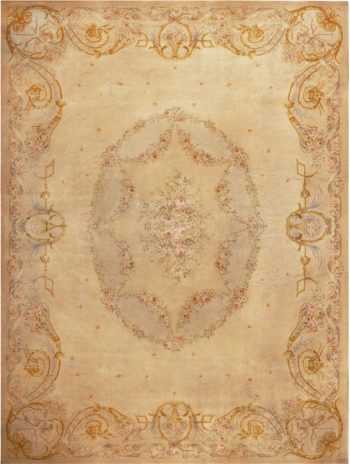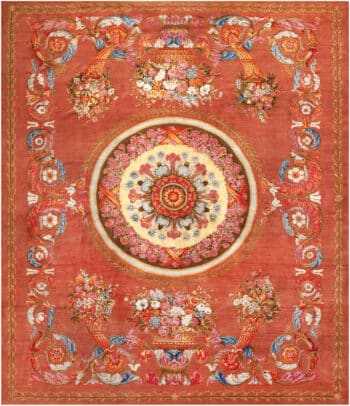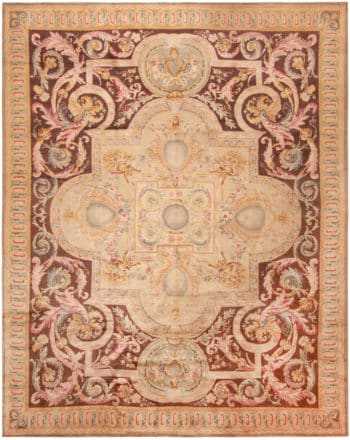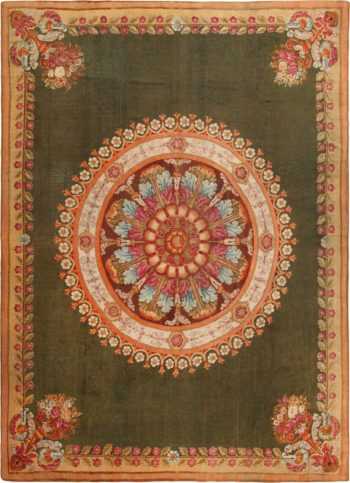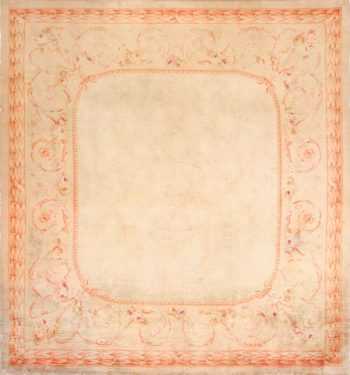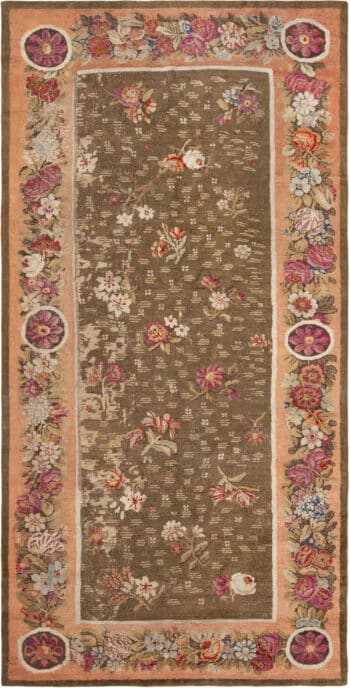Antique Savonnerie Carpets From France
Romance Your Space: Discover The Distinctive Charm Of Antique French Savonnerie Rugs
View Our Collection Of Antique Savonnerie Carpets and Rugs
Oversized Antique Spanish Savonnerie Rug 72914
$69,000.00Size: 15 ft 10 in x 26 ft (4.83 m x 7.92 m)Large Green Antique Spanish Savonnerie Carpet 49845
$54,000.00Size: 15 ft 6 in x 19 ft (4.72 m x 5.79 m)Large Floral Antique French Savonnerie Carpet 49848
$62,000.00Size: 13 ft 6 in x 18 ft (4.11 m x 5.49 m)Beautiful Elegant Large Vintage Classic Renaissance Savonnerie Style Rug 71970
$26,500.00Size: 14 ft 4 in x 17 ft 8 in (4.37 m x 5.38 m)Beautiful Large Antique Renaissance French Savonnerie Rug 50184
$48,000.00Size: 10 ft 2 in x 17 ft (3.1 m x 5.18 m)Spectacular Large Antique French Savonnerie Carpet 72695
Size: 14 ft 4 in x 16 ft 3 in (4.37 m x 4.95 m)Large Antique French Savonnerie Rug 72306
Size: 13 ft x 16 ft 1 in (3.96 m x 4.9 m)Washed Out Antique Geometric French Art Deco Rug 50089
$68,000.00Size: 13 ft 7 in x 14 ft 2 in (4.14 m x 4.32 m)Antique French Charles X Savonnerie Rug 70965
$79,000.00Size: 10 ft 5 in x 14 ft 1 in (3.17 m x 4.29 m)Open Field Square Antique French Renaissance Soft Decorative Savonnerie Area Rug 48999
$28,000.00Size: 11 ft 10 in x 12 ft 8 in (3.61 m x 3.86 m)Antique French Savonnerie Floral Gallery Size Rug 72531
Size: 5 ft 11 in x 12 ft 3 in (1.8 m x 3.73 m)
Learn More About Antique French Savonnerie Carpets
Savonnerie Carpets – During the early seventeenth century, a weaver named Pierre DuPont traveled to the Levant. Upon his return, he claimed to have discovered the technique of creating Turkish rugs. Oriental rugs were extremely expensive during Bourbon times, and a French manufactory that could create the same type of rug would lower the price significantly. Henri VI of France–the reigning monarch at the time–took advantage of DuPont’s skills and established a workshop for him at the Louvre. In 1627, King Louis XIII founded a manufactory for DuPont and his apprentice, Simon Lourdet, on the site of a defunct soap factory in the sixteenth arrondissement (also known as Quai de Chaillot). The name “Savonnerie” was born from the French word “savon” meaning “soap.” DuPont and Lourdet worked together, weaving rugs under a royal patent for the king and other nobles, until they had a falling out and split up. Lourdet remained at the Chaillot location while DuPont went to his workshops in the Louvre, though both continued to make Savonnerie rugs.
DuPont’s discovery was an ancient weaving technique called the Ghiordes knot. The Ghiordes is the oldest known knot used in carpet production. It consists of a symmetrical structure achieved by passing a single weft yarn over two warp yarns, pulling through between before severing the yarn to create the pile. The Ghiordes knot is characteristic of Turkish rugs. This weaving technique created a more durable structure than the tapestries created by European weavers. Tapestries were hung on walls, while the Turkish style French rugs were sturdy enough for foot traffic.
When Louis XVI came to the French throne in 1643, he was a mere five years old, but in 1659 he began a phase of renovations for the Palais de Louvre, at which he commissioned 274 carpets — all of a length of twenty-nine feet with varying widths–from the Savonnerie manufactory. The process was grueling and did not end until 1697 when the final carpet for the Louvre was woven. His favorite artist, Charles Le Brun, drew up cartoons of rug designs for the Louvre’s Grande Galerie. The designs consisted of a dark-colored background, filled with motifs of scrolls, cornucopias, flowers, arms of France, and the monogram of Louis. Inventories of Louis’ possessions show that in the early years of his reign, he had a number of Turkish and Persian rugs, though they were gradually superseded by Savonnerie carpets. At the same time, King Louis was hard at work supervising the construction of his grand new palace at Versailles, and he moved his residence at the Louvre for Versailles in 1678.
Savonnerie carpets also served as grand diplomatic gifts from Louis to foreign ambassadors and other notables. He gifted a collection of music-themed Savonnerie creations to the ambassador of Siam, where they stayed intact and in use for hundreds of years.
The legacy of the Savonnerie manufactory was a great one. The area carpets remained the exclusive property of the French rulers until 1768. In the same century, the classic Savonnerie designs were updated with lighter, brighter colors and Rococo elements. The production of Savonnerie rugs declined in the latter half of the eighteenth century, until 1805 when the designs were revived by Napoleon. Twenty years later, the Savonnerie workshop merged with the Gobelins tapestry manufactory. This marked the end of its independence, though the production was ever steady. A number of the first Savonnerie designs still exist today, having survived the Fronde, the French Revolution, and two World Wars. They have avoided going out of fashion by reinventing themselves from Louis XIV style to Rococo to French Empire to Art Deco and beyond.
Antique French Savonnerie rugs exemplify the formal grace and elegance of classical European design. Like Aubusson tapestry rugs, Savonneries originated in France when European taste turned away for a time from Oriental carpets in the later eighteenth and earlier nineteenth centuries. Named for nearby factories that produced soap or “savon,” Savonnerie rugs shared with Aubussons a Neo-Classical taste for naturalistic flowers and swags or garlands in soft colors on a dominant ivory field, except that they were made in knotted pile rather than tapestry technique. Later, carpets of this kind were made in other European centers, most notably in Spain.
History of Antique Savonnerie Carpets and Rugs from France By Nazmiyal
In a former Parisian soap factory known as the Savonnerie young orphans worked alongside artisan carpet weavers producing knotted pile rugs for the crown ruler’s palaces. Savonnerie carpets enjoyed tremendous popularity throughout the 17th century.
However royal finances the French revolution and the invention of steam powered looms led to the demise of the legendary Savonnerie factory. Before the Savonnerie was established France imported the majority of their rugs from the ottoman empire through the Franco ottoman alliance and trade agreements. Master weaver Pierre DuPont who had just returned from a trip to the Levant and the eastern Mediterranean region including Iraq, Jordan, Lebanon and Syria believed he could refine tribal rug designs from the Levant to suit the refined taste of the French court.
In 1608 Henry IV better known as Henry the great commissioned DuPont and his apprentice Simon Lourdes to produce carpets from a workshop in the Louvre the weaving team quickly outgrew the Louvre studio instigating a move to the larger Savonnerie factory in the suburbs of Paris although the first Savonnerie carpets imitated Persian designs themes quickly changed to reflect French baroque neoclassical and rococo elements such as architectural framed medallions dense bouquets and elaborate scrolls that were more fitting with the typical French style of the Louvre palace and Versailles under the rule of Louis XIV the Savonnerie factory and style thrived. At the height of the Savonnerie movement a large staff of interns journeymen and successful designers were employed and housed by the royal factory.
Many iconic Savonnerie carpets were adapted from designs produced by the king’s royal painter Charles Le Brun who served as the director and chief designer for both the Savonnerie and the prestigious gobelin dye-works and tapestry “weavery”. Under the direction of Jean Baptiste Colbert the minister of finance for Louis xiv an unprecedented order for more than 100 carpets was placed to furnish the galerie d’apollon and the massive grade galerie of the Louvre palace.
Unfortunately by the time the carpets were complete Louis XIV had all but abandoned the Louvre in favor of his palace at Versailles so none of the carpets were permanently installed. The year 1683 spelled a great change for Franco ottoman relations and the Savonnerie factory. When the ottoman empire launched a military offensive against Vienna France severed relations and banned an import on near eastern and oriental rugs to ensure the security of the French carpet market.
Until the end of the 17th century the Savonnerie was a thriving factory that employed up to sixty teen and preteen orphans who were taught carpet weaving and design skills for six years before graduating to the journeyman level. By the end the 1690’s war and financial indiscretions brought an end to the golden days of the Savonnerie in the 18th century a number of rococo Savonnerie carpets were created with lighter colors associated with the delicate and ornate style of the movement.
Due to the popularity of Savonnerie rugs many factories attempted to imitate the classic style. In 1750 two disgruntled Savonnerie workers immigrated to England where they introduced their carpet weaving techniques to factories in Axminster and Wilton. Factories in the French textile city of Aubusson also imitated the Savonnerie style attempting to capture a segment of the market that was unable to acquire genuine Savonnerie rugs leading up to the French Revolution. However copies produced in Aubusson were never able to replicate the velvety pile of Savonnerie rugs.
During the French Revolution many Savonnerie carpets were either auctioned and traded as currency or defaced to remove Fleur De Lys and other symbols representing the monarchy. Although the Savonnerie tradition was briefly revived in the 1800’s to produce neoclassical and empire style rugs commissioned by napoleon The French Revolution in 1789 marked the beginning of the end for the Savonnerie factory. Despite the dramatic ending the Savonnerie style remained influential in Europe for more than 200 years after the factory closed.



